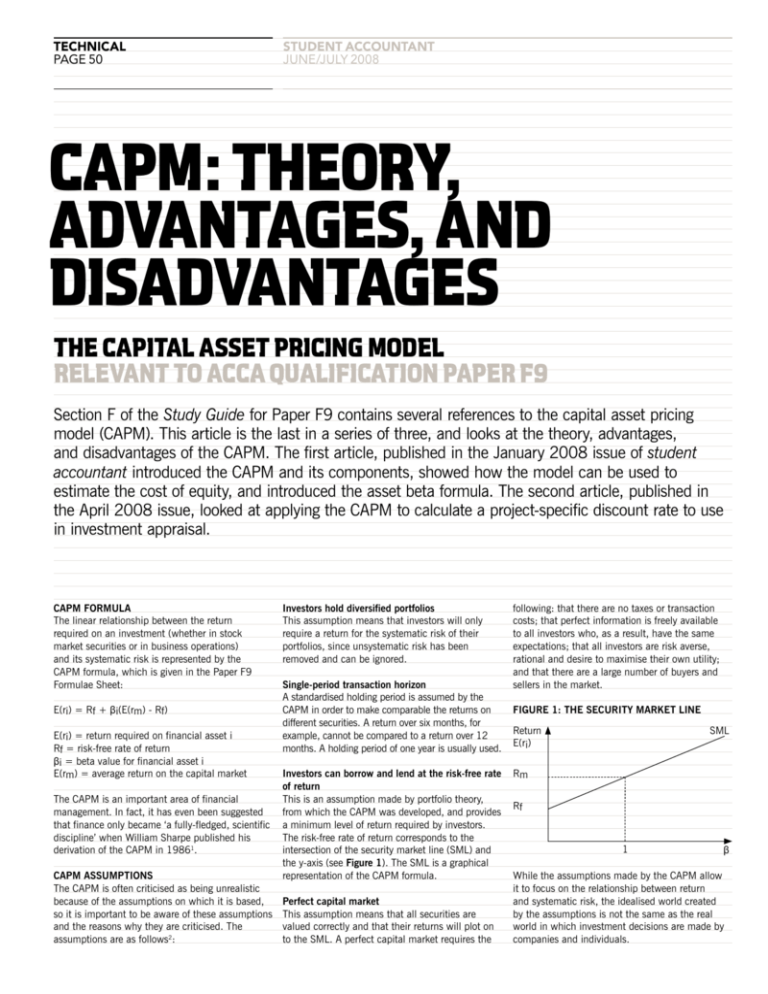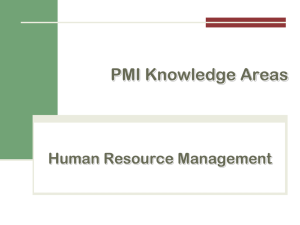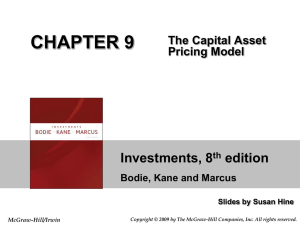CAPM: Theory, Advantages, and Disadvantages
advertisement

technical page 50 student accountANT JUNE/JULY 2008 CAPM: THEORY, ADVANTAGES, AND DISADVANTAGES THE CAPITAL ASSET PRICING MODEL RELEVANT TO ACCA QUALIFICATION PAPER F9 Section F of the Study Guide for Paper F9 contains several references to the capital asset pricing model (CAPM). This article is the last in a series of three, and looks at the theory, advantages, and disadvantages of the CAPM. The first article, published in the January 2008 issue of student accountant introduced the CAPM and its components, showed how the model can be used to estimate the cost of equity, and introduced the asset beta formula. The second article, published in the April 2008 issue, looked at applying the CAPM to calculate a project-specific discount rate to use in investment appraisal. CAPM FORMULA The linear relationship between the return required on an investment (whether in stock market securities or in business operations) and its systematic risk is represented by the CAPM formula, which is given in the Paper F9 Formulae Sheet: E(ri) = Rf + βi(E(rm) - Rf) E(ri) = return required on financial asset i Rf = risk-free rate of return βi = beta value for financial asset i E(rm) = average return on the capital market The CAPM is an important area of financial management. In fact, it has even been suggested that finance only became ‘a fully-fledged, scientific discipline’ when William Sharpe published his derivation of the CAPM in 19861. CAPM ASSUMPTIONS The CAPM is often criticised as being unrealistic because of the assumptions on which it is based, so it is important to be aware of these assumptions and the reasons why they are criticised. The assumptions are as follows2: Investors hold diversified portfolios This assumption means that investors will only require a return for the systematic risk of their portfolios, since unsystematic risk has been removed and can be ignored. Single-period transaction horizon A standardised holding period is assumed by the CAPM in order to make comparable the returns on different securities. A return over six months, for example, cannot be compared to a return over 12 months. A holding period of one year is usually used. Investors can borrow and lend at the risk-free rate of return This is an assumption made by portfolio theory, from which the CAPM was developed, and provides a minimum level of return required by investors. The risk-free rate of return corresponds to the intersection of the security market line (SML) and the y-axis (see Figure 1). The SML is a graphical representation of the CAPM formula. Perfect capital market This assumption means that all securities are valued correctly and that their returns will plot on to the SML. A perfect capital market requires the following: that there are no taxes or transaction costs; that perfect information is freely available to all investors who, as a result, have the same expectations; that all investors are risk averse, rational and desire to maximise their own utility; and that there are a large number of buyers and sellers in the market. FIGURE 1: THE SECURITY MARKET LINE Return E(ri) SML Rm Rf 1 β While the assumptions made by the CAPM allow it to focus on the relationship between return and systematic risk, the idealised world created by the assumptions is not the same as the real world in which investment decisions are made by companies and individuals. For example, real-world capital markets are clearly not perfect. Even though it can be argued that well-developed stock markets do, in practice, exhibit a high degree of efficiency, there is scope for stock market securities to be priced incorrectly and, as a result, for their returns not to plot on to the SML. The assumption of a single-period transaction horizon appears reasonable from a real-world perspective, because even though many investors hold securities for much longer than one year, returns on securities are usually quoted on an annual basis. The assumption that investors hold diversified portfolios means that all investors want to hold a portfolio that reflects the stock market as a whole. Although it is not possible to own the market portfolio itself, it is quite easy and inexpensive for investors to diversify away specific or unsystematic risk and to construct portfolios that ‘track’ the stock market. Assuming that investors are concerned only with receiving financial compensation for systematic risk seems therefore to be quite reasonable. A more serious problem is that, in reality, it is not possible for investors to borrow at the risk-free rate (for which the yield on short-dated Government debt is taken as a proxy). The reason for this is that the risk associated with individual investors is much higher than that associated with the Government. This inability to borrow at the risk-free rate means that the slope of the SML is shallower in practice than in theory. Overall, it seems reasonable to conclude that while the assumptions of the CAPM represent an idealised rather than real-world view, there is a strong possibility, in reality, of a linear relationship existing between required return and systematic risk. WACC AND CAPM The weighted average cost of capital (WACC) can be used as the discount rate in investment appraisal provided that a number of restrictive assumptions are met. These assumptions are that: the investment project is small compared to the investing organisation the business activities of the investment project are similar to the business activities currently undertaken by the investing organisation the financing mix used to undertake the investment project is similar to the current financing mix (or capital structure) of the investing company existing finance providers of the investing company do not change their required rates of return as a result of the investment project being undertaken. These assumptions essentially state that WACC can be used as the discount rate provided that linked performance objectives performance objectives 15 and 16 are relevant to paper F9 the investment project does not change either the business risk or the financial risk of the investing organisation. If the business risk of the investment project is different to that of the investing organisation, the CAPM can be used to calculate a project-specific discount rate. The procedure for this calculation was covered in the second article in this series3. The benefit of using a CAPM-derived project‑specific discount rate is illustrated in Figure 2. Using the CAPM will lead to better investment decisions than using the WACC in the two shaded areas, which can be represented by projects A and B. Project A would be rejected if WACC was used as the discount rate, because the internal rate of return (IRR) of the project is less than that of the WACC. This investment decision is incorrect, however, since project A would be accepted if a CAPM‑derived project-specific discount rate were used because the project IRR lies above the SML. The project offers a return greater than that needed to compensate for its level of systematic risk, and accepting it will increase the wealth of shareholders. Project B would be accepted if WACC was used as the discount rate because its IRR is greater than the WACC. This investment decision is also incorrect, however, since project B would be rejected if using a CAPM-derived project-specific discount rate, because the project IRR offers insufficient compensation for its level of systematic risk4. FIGURE 2: WACC OR CAPM? Required rate of return % technical page 51 SML D C x x B WACC A Rf 0 Company β β ADVANTAGES OF THE CAPM The CAPM has several advantages over other methods of calculating required return, explaining why it has remained popular for more than 40 years: It considers only systematic risk, reflecting a reality in which most investors have diversified portfolios from which unsystematic risk has been essentially eliminated. technical page 52 It generates a theoretically-derived relationship between required return and systematic risk which has been subject to frequent empirical research and testing. It is generally seen as a much better method of calculating the cost of equity than the dividend growth model (DGM) in that it explicitly takes into account a company’s level of systematic risk relative to the stock market as a whole. It is clearly superior to the WACC in providing discount rates for use in investment appraisal. DISADVANTAGES OF THE CAPM The CAPM suffers from a number of disadvantages and limitations that should be noted in a balanced discussion of this important theoretical model. Assigning values to CAPM variables In order to use the CAPM, values need to be assigned to the risk-free rate of return, the return on the market, or the equity risk premium (ERP), and the equity beta. The yield on short-term Government debt, which is used as a substitute for the risk-free rate of return, is not fixed but changes on a daily basis according to economic circumstances. A short-term average value can be used in order to smooth out this volatility. Finding a value for the ERP is more difficult. The return on a stock market is the sum of the average capital gain and the average dividend yield. In the short term, a stock market can provide a negative rather than a positive return if the effect of student accountANT JUNE/JULY 2008 falling share prices outweighs the dividend yield. It is therefore usual to use a long-term average value for the ERP, taken from empirical research, but it has been found that the ERP is not stable over time. In the UK, an ERP value of between 2% and 5% is currently seen as reasonable. However, uncertainty about the exact ERP value introduces uncertainty into the calculated value for the required return. Beta values are now calculated and published regularly for all stock exchange-listed companies. The problem here is that uncertainty arises in the value of the expected return because the value of beta is not constant, but changes over time. Using the CAPM in investment appraisal Problems can arise when using the CAPM to calculate a project-specific discount rate. For example, one common difficulty is finding suitable proxy betas, since proxy companies very rarely undertake only one business activity. The proxy beta for a proposed investment project must be disentangled from the company’s equity beta. One way to do this is to treat the equity beta as an average of the betas of several different areas of proxy company activity, weighted by the relative share of the proxy company market value arising from each activity. However, information about relative shares of proxy company market value may be quite difficult to obtain. A similar difficulty is that the ungearing of proxy company betas uses capital structure information that may not be readily available. Some companies have complex capital structures with many different sources of finance. Other companies may have debt that is not traded, or use complex sources of finance such as convertible bonds. The simplifying assumption that the beta of debt is zero will also lead to inaccuracy in the calculated value of the project-specific discount rate. One disadvantage in using the CAPM in investment appraisal is that the assumption of a single-period time horizon is at odds with the multi-period nature of investment appraisal. While CAPM variables can be assumed constant in successive future periods, experience indicates that this is not true in reality. CONCLUSION Research has shown the CAPM to stand up well to criticism, although attacks against it have been increasing in recent years. Until something better presents itself, however, the CAPM remains a very useful item in the financial management toolkit. REFERENCES 1 Megginson W L, Corporate Finance Theory, Addison-Wesley, p10, 1996. 2 Watson D and Head A, 2007, Corporate Finance: Principles and Practice, 4th edition, FT Prentice Hall, pp222–3. 3 Project-specific discount rates, student accountant, April 2008. 4 Watson and Head, pp252–3. Tony Head is examiner for Paper F9







